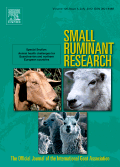
SMALL RUMINANT RESEARCH
Scope & Guideline
Fostering excellence in animal science research.
Introduction
Aims and Scopes
- Genetic Diversity and Breeding:
Research on the genetic diversity, breeding programs, and genetic markers associated with desirable traits in small ruminants. This includes studies on polymorphisms in specific genes and their correlation with growth, reproductive performance, and disease resistance. - Nutrition and Feed Efficiency:
Investigations into the nutritional requirements and feed efficiency of small ruminants, including the effects of different feed types, supplements, and feeding strategies on growth performance, health, and meat quality. - Health and Disease Management:
Studies focused on the health challenges faced by small ruminants, including infectious diseases, metabolic disorders, and the efficacy of vaccines and treatments to improve animal welfare and productivity. - Reproductive Physiology:
Research examining the reproductive physiology of small ruminants, including estrus synchronization, fertility treatments, and the impact of environmental factors on reproductive traits. - Sustainable Production Systems:
Exploration of sustainable management practices for small ruminants, including pasture management, integrated crop-livestock systems, and the socio-economic aspects of small ruminant production. - Behavior and Welfare:
Studies on the behavioral responses of small ruminants to various management practices and environmental conditions, aiming to enhance animal welfare and production efficiency.
Trending and Emerging
- Climate Change Adaptation:
There is an increasing focus on how small ruminants can adapt to climate change, with studies investigating physiological adaptations, management practices, and breeding for resilience in extreme environments. - Precision Livestock Farming:
Emerging technologies, including machine learning and sensor technologies, are being applied to monitor and optimize the health and production of small ruminants, indicating a trend towards precision livestock farming. - Nutritional Supplements and Feed Additives:
Research on the use of novel nutritional supplements and feed additives, such as phytogenic compounds and enzymes, to enhance growth performance, health, and reduce environmental impacts is gaining traction. - Microbiome Studies:
Exploration of the gut microbiome and its impact on health, digestion, and productivity in small ruminants is becoming a significant area of interest, reflecting a broader trend in livestock research. - Welfare and Behavioral Studies:
There is a growing emphasis on the welfare of small ruminants, with studies focusing on behavioral responses to management practices and environmental conditions, indicating an increasing awareness of animal welfare issues.
Declining or Waning
- Traditional Breeding Practices:
Research related to traditional breeding practices and indigenous breeds is becoming less frequent as more emphasis shifts towards genetic improvement through modern techniques and genomic selection. - Purely Theoretical Studies:
There is a noticeable decline in studies that focus solely on theoretical models without practical applications or real-world relevance, as the journal increasingly favors research with direct implications for small ruminant management. - Environmental Impact Studies:
While environmental impact studies were previously prominent, there appears to be a waning interest as more specific research on sustainable practices and adaptation strategies takes precedence. - Antibiotic Resistance Research:
Research on antibiotic resistance in small ruminants has seen a reduction, possibly due to shifting focus towards alternative health management practices and preventative measures.
Similar Journals
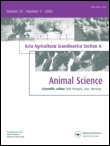
ACTA AGRICULTURAE SCANDINAVICA SECTION A-ANIMAL SCIENCE
Unveiling the Science Behind Animal Welfare and ProductivityACTA AGRICULTURAE SCANDINAVICA SECTION A-ANIMAL SCIENCE, published by Taylor & Francis AS, offers a vital platform for the dissemination of research in the field of animal science. With an ISSN of 0906-4702 and an E-ISSN of 1651-1972, this esteemed journal is based in the United Kingdom and covers critical studies pertaining to animal biology, production, and welfare. Although it operates under a non-open access model, the journal maintains a commendable position in the academic community, evidenced by its Q3 category ranking in both animal science and food animals for 2023, reflecting a sustained impact in these domains. Covering research from 1992 to 2018 and continuing from 2020 to 2024, the journal provides insights crucial for addressing contemporary issues in livestock production, veterinary sciences, and animal breeding. Researchers, professionals, and students alike will find this journal indispensable for enhancing their understanding and advancing the field of animal sciences.

Applied Animal Science
Advancing Knowledge in Animal and Food SciencesApplied Animal Science, published by Elsevier Science Inc, is an esteemed journal that has quickly made its mark in the fields of Animal Science and Food Science since its inception in 2019. With an ISSN of 2590-2873 and an E-ISSN of 2590-2865, this journal has received commendable recognition, achieving a Q2 ranking in both categories as of 2023. Encompassing a broad scope that integrates cutting-edge research and practical applications, Applied Animal Science seeks to disseminate knowledge that advances the well-being of animal systems and food safety. Researchers and professionals in the agricultural and biological sciences benefit from its high-quality articles, which are ranked #152 out of 490 and #200 out of 389 in their respective fields according to Scopus rankings. While currently not open access, the journal remains accessible to a global audience of scholars eager to explore innovative findings and robust methodologies. As it continues to grow through 2024 and beyond, Applied Animal Science aims to be a pivotal platform for fostering knowledge exchange and inspiring future studies in its domain.

ANIMAL SCIENCE PAPERS AND REPORTS
Pioneering Insights in Animal Science and Veterinary AdvancementsANIMAL SCIENCE PAPERS AND REPORTS, published by the Polish Academy of Sciences, Institute of Genetics and Animal Biotechnology, is a distinguished platform for interdisciplinary research reflecting the evolving fields of Animal Science, Biotechnology, and Genetics. With an ISSN of 0860-4037 and an E-ISSN of 2300-8342, this journal serves as an essential resource for researchers and professionals aiming to advance their understanding and apply innovative methodologies in veterinary science and animal biotechnology. Despite being classified in Quartile 4 across several categories in 2023 and noting a notable country-based focus in Poland, it continues to provide valuable insights into animal genetics and biotechnological advancements, particularly as it converges its content from 2007 to 2024. While currently not an open access journal, ANIMAL SCIENCE PAPERS AND REPORTS is committed to upholding academic rigor, making it a key asset for students, researchers, and industry professionals looking to contribute to and stay informed in these vital scientific areas.

TROPICAL ANIMAL HEALTH AND PRODUCTION
Elevating standards in tropical animal care and production.Tropical Animal Health and Production is a prominent academic journal dedicated to advancing the field of animal health and production in tropical environments. Published by Springer, this journal has been a pivotal platform for researchers and professionals since its inception in 1969, serving as a vital resource for innovative studies and advancements up to 2024. With impactful research findings, it holds a respectable Q2 ranking in both Animal Science and Zoology, and Food Animals, demonstrating its significance within these fields. The journal’s commitment to high-quality research is further reflected in its Scopus rankings, with a notable position in Agricultural and Biological Sciences and Veterinary Food Animals. Although it is not an open-access publication, the insights and knowledge shared within its pages are invaluable for those engaged in tackling the challenges of animal health and production in the tropics. Researchers and students will find Tropical Animal Health and Production an essential source for the most recent advancements and practices in veterinary science and animal care for food-producing species.

Translational Animal Science
Bridging Science and Practice for Animal WelfareTranslational Animal Science, published by Oxford University Press Inc, stands as a prominent journal in the fields of Animal Science and Zoology as well as Veterinary Sciences, achieving a commendable Q2 ranking in both categories for 2023. With an E-ISSN of 2573-2102 and transitioning to an Open Access model since 2017, this journal fosters accessibility and dissemination of vital research that bridges the gap between basic animal science and its practical applications. The journal's significant impact factor, where it ranks in the 71st and 65th percentiles respectively for Veterinary and Agricultural and Biological Sciences disciplines, highlights its importance as a resource for emerging trends and innovations in animal research. With submissions accepted until 2024, Translational Animal Science not only contributes to advancing knowledge but also aims to engage a broad audience of researchers, professionals, and students dedicated to improving animal health and welfare. Based in India, the journal serves as an essential platform for the exchange of scientific ideas that facilitate progress within these vital fields.
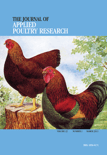
JOURNAL OF APPLIED POULTRY RESEARCH
Unlocking insights in poultry research and management.The Journal of Applied Poultry Research, published by Elsevier, stands as a pivotal resource in the field of poultry science. Established in 1992, this esteemed journal has transitioned to an Open Access model since 2020, fostering broader dissemination and accessibility of research findings. With an ISSN of 1056-6171 and an E-ISSN of 1537-0437, it is indexed in prominent databases, achieving a commendable Q2 ranking in the Animal Science and Zoology category as of 2023, placing it in the top 20% of journals in its field (Rank #91 out of 490, 81st percentile). The journal aims to advance the science and practice of poultry research, covering areas such as nutrition, genetics, management, and welfare. With editorial oversight that ensures rigorous peer review, the Journal of Applied Poultry Research is a vital platform that supports researchers, professionals, and students dedicated to enhancing poultry production and sustainability. Its commitment to high-quality research makes it an essential read for anyone involved in poultry science, agriculture, and related disciplines.
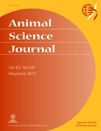
ANIMAL SCIENCE JOURNAL
Advancing the Frontiers of Animal ScienceAnimal Science Journal, published by Wiley, stands as a premier platform for advancing knowledge in the fields of Agricultural and Biological Sciences, Animal Science and Zoology, and Food Science. With an ISSN of 1344-3941 and an E-ISSN of 1740-0929, this journal not only enjoys a commendable Q2 ranking across multiple categories, reflecting its significance and impact within the academic community, but it also ranks within the top percentiles in terms of Scopus rankings. Operating out of the United Kingdom, the journal covers a broad spectrum of research topics relevant to animal science, encompassing both theoretical insights and practical applications. While it is not an open access journal, it remains an essential resource for researchers and practitioners eager to enhance their understanding of animal sciences, contribute to ongoing debates, and stay abreast of the latest findings from 2003 through 2024. Scholar engagement and innovative research are central to the journal’s objectives, making it an invaluable asset for students, professionals, and academics alike.
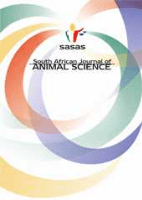
SOUTH AFRICAN JOURNAL OF ANIMAL SCIENCE
Elevating standards in animal husbandry and breeding practices.SOUTH AFRICAN JOURNAL OF ANIMAL SCIENCE is a leading scholarly publication dedicated to the dissemination of original research, review articles, and critical insights in the fields of animal science and zoology. Established in 1974, this journal is published by the South African Journal of Animal Sciences and has since become an essential resource for researchers and professionals in the field. The journal, which currently holds a Q3 ranking in Animal Science and Zoology as per Scopus rankings, aims to promote scientific knowledge and innovation in animal husbandry, welfare, nutrition, and breeding practices, with a particular emphasis on the South African context. The journal's rigorous peer-review process ensures high-quality research is shared widely among the academic community. Researchers and students alike will find valuable content and access options that support ongoing education and professional development in this vital area of study. For more information, interested readers can contact the editorial office at PO Box 13884, Hatfield 0028, South Africa.

CANADIAN JOURNAL OF ANIMAL SCIENCE
Unveiling the Science Behind Animal Welfare and AgricultureCanadian Journal of Animal Science, published by Canadian Science Publishing, stands as a pivotal platform in the fields of Animal Science and Zoology, reflecting its commitment to advancing knowledge and research in these crucial areas. Operating since 1975, with dedicated publication since 1993, this journal boasts an impactful history and has established itself within the academic community, holding a 2023 Q2 category rank in Animal Science and Zoology, and a Q3 rank in Food Animals. With its ISSN 0008-3984 and E-ISSN 1918-1825, the journal is accessible to a wide audience, promoting collaboration and the dissemination of innovation across borders. Although not an open-access journal, its valuable insights and research findings serve as essential resources for researchers, professionals, and students striving to enhance their understanding of animal science, veterinary studies, and agricultural practices. As the field of animal science continues to evolve, the Canadian Journal of Animal Science remains a vibrant and influential part of this dynamic landscape.
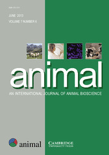
Animal
Bridging research and practice in veterinary medicine and wildlife management.Animal is a leading academic journal published by Elsevier that stands at the forefront of research in the field of Animal Science and Zoology. Founded in 2007, it has rapidly garnered a prestigious reputation, achieving a remarkable Q1 ranking in its category for the year 2023, placing it in the top 4% of journals in the discipline. With an impressive impact, as indicated by its rank of 19 out of 490 in Agricultural and Biological Sciences on Scopus, this journal serves as a vital platform for researchers, professionals, and students to disseminate groundbreaking findings and interdisciplinary studies. Animal not only offers paid subscription access but also provides an option for Open Access, thereby enhancing the visibility and reach of significant research contributions. With its comprehensive scope and commitment to advancing the understanding of animal biology, behavior, and welfare, Animal plays a crucial role in shaping the future of animal science. For anyone invested in the environment, veterinary medicine, or wildlife management, this journal is an essential resource that fosters knowledge exchange and continued developments in the field.